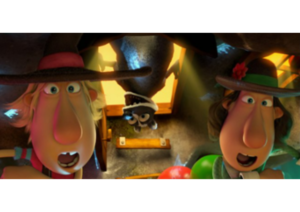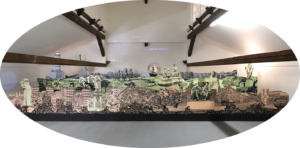výstava „Síň slávy české animace“ /Hall of Fame/
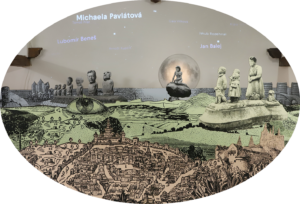
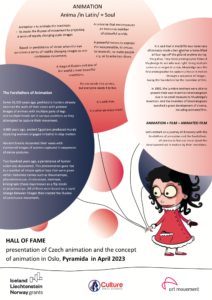
PRODUCTION OF AN ANIMATED FILM IN NINE STEPS
1 – Story
Story is at the beginning of every film. Its form reminds us of a short story.
2 – Written Script
It has a prescribed form. The plot (or action) and the dialogue are outlined separately in several paragraphs. Everything is written in such a way as to give a clear idea of what the final film will be like.
3 – Storyboard
The narrative is translated into pictures, just as in a comic book. The storyboard shows how many shots will be in the film, from where and from what distance the action will be taken by the camera. It includes dialogues, instructions for the composer or the producer of the film’s tricks.
4 – Animatic
The images from the storyboard are lined up in the editing room according to the length of each shot. Rough recording of dialogues is made and soundtrack roughly set to the film completes the whole. The result is a simple film that gives the filmmakers an accurate idea of how the film works as a whole, what needs to be changed or even cut out. The animatic is used as a reference for filming.
5 – Artwork
Every character, prop and asset must be designed by an artist before production. For large projects, the artist has a whole department of assistant artists working in his or her style. This results in a lot of images, sketches, model kits and computer models.
6 – Animation Studio
In the animation studio, the entire film is animated frame by frame. It results in a huge number of shots without sound (a feature film has a lot more than 1000).
7 – Editing Room
In the editing room, the finished footage is arranged in the correct order, the length of the shots is fine-tuned, and the final rhythm of the film is determined. At the same time, assignments for the production of film tricks, music and sound are conceived.
8 – Trick Post-Production
If tricks are needed, they are prepared for the film. There are a number of these, the vast majority of which are produced using computers. These include retouching what should not be in the shot, adding backgrounds, adding effects such as explosions, fire and smoke, or adding computer-generated animated objects and characters. The film will also be given end credits in digital post-production.
Finally, the film is given a final colour finish, the shots are matched to each other in terms of contrast and brightness, and the colour mood of each scene is completed. This process is called colour grading.
And with that, the film image is finished.
9 – Sound Studio
In the sound studio, the final dialogue (character voices), music and foley effects are recorded. The foley effects are the sounds of footsteps, rustling grass, creaking doors, etc. Among Czech filmmakers, they are also known as brunclíks in honour of the legendary sound designer Bohumír Brunclík.
All the sounds are put in the correct place and their volume is adjusted (which is called sound mixing). The final soundtrack for cinema or television is created.
Final image + final sound = finished film
ANIMATION TECHNIQUES
TECHNIQUES UNDER THE CAMERA
These are techniques where the camera hangs suspended, looking down at a table on which the animator animates or takes pictures of finished pre-prepared images (or phases). The camera can zoom in and out (getting closer or further away), and the whole table moves sideways.
Cartoon Animation
The animation is drawn on papers or transparent foils, or cels. These allow for the use of painted backgrounds or multiple layers with characters.
In order to ensure that the individual images remain in the same place and that the movement drawn on them is smooth, they are fixed with metal pegs.
If the individual planes (layers) with characters and backgrounds are arranged on several layers of glass (multiplane), the camera movement can create a partially spatial impression.
Today, cartoon animation is created in the computer. Instead of pencils and brushes, artists use graphic tablets, the individual layers are no longer taken under the camera, they are animated in the computer. But the principle remains the same.
A specific discipline of cartoon animation is called rotoscoping. It is created by tracing characters filmed in real time with a normal camera. The most famous examples are Disney’s Snow White or the Czech film Alois Nebel (dir. Tomáš Luňák).
Cut-out Film
A character is painted on carboard or other flat solid surface (sheet metal, plastic, wood…) and is divided into parts. The animator moves them directly under the camera and the individual phases of movement are recorded by the camera ̶ on a film strip as in the past, on the computer as it is done today. As with cartoon film, layers can be used, spread over several planes of the animation table, to achieve spatial effects.
Relief Film
Animated in a similar way to cut-out film, but the objects are partly spatial, so that light and shadow are reflected on them; the resulting impression is reminiscent of puppet film.
The puppets have a so-called skeleton – a mechanism that allows them to be adjusted to different positions.
Paint-on-Glass Animation
The animator paints with oil paints on the glass directly under the camera, slightly adjusting the painting for each frame. The glass is illuminated from below. Some parts of the image are painted on cels in advance and the animator uses them as they are. Several sheets (planes) of painted glass are used to achieve spatial effects (out of focus, movement of each plane in perspective, etc.).
Other Traditional Techniques
Almost anything can be animated. All sorts of objects are animated – from dishes to cars, flowers, modelling clay, ceramic clay, stones, beads, cotton yarn and many other materials; the imagination has no limits.
Sand animation is a very effective technique. The sand is poured on the light table and the animator animates it with his or her hands, pouring the sand or using brushes. Different layers of sand, when illuminated, produce different shades from black (where the table light does not shine through the thick layer) to white (where there is no sand).
A very specific technique is pin-screen.
It is a frame with a fine screen. Countless pins are inserted into its holes. By illuminating it from the side, a shadow is created, the intensity of which can be changed by sliding the pins in and out. Various objects such as rollers are used to this end. After each exposure, the composition of the pins changes slightly, thus creating animation. The result is a monochromatic image with soft hatching.
Some animators in the age of film cameras experimented, achieving rather strange and impressive results by not recording the image, but by drawing the image frame by frame directly on the film strip (a film frame is only about 20mm wide), by engraving it or by etching it using various chemicals.
TECHNIQUES IN FRONT OF THE CAMERA
In these techniques, the camera stands on a tripod, similar to live-action films. Its movements are generated devices that allow for the animation in tiny steps. The original solution was camera heads animated by rotating cranks, today movements are initiated by stepper motors controlled by a computer (called Motion Control).
Puppet Animation
Puppets with animation skeletons stand in front of the camera. This allows the animator to set the puppet in the desired pose so that it stays in the pose until the image is captured by the camera ̶ on a filmstrip as in the past or digitally using a computer as it is done today.
The puppets are made from a variety of materials – from wood, leather, fabric and fur to plastic, latex and silicone or plasticine. Karel Zeman even animated glass puppets for his Inspiration – the animators heated them up with glass blowers and then arranged them just as they would have done with regular animation puppets.
The puppets‘ faces were originally still, but today they are animated. Either the puppet’s head is fitted with an animation skeleton like the body, or the whole or parts of the head are replaced to create individual facial expressions.
Pixilation
Similar to puppet animation, but instead of a puppet, a live actor is present. The animator arranges him or her in static positions and then records them on camera. The process is repeated over and over again until an animated sequence is created.
CG TECHNIQUES
CG = Computer Generated
2D = two-dimensional = flat / corresponds to cartoon or cut-out animation
3D = three-dimensional = spatial / corresponds to stop-motion (puppet) film
2.5D = semi-spatial / corresponds to relief film
Just as in traditional techniques, characters, props and assets are created based on the artist’s designs. The only difference is that computers are used instead of tangible materials. The principle, however, remains the same and the work is just as laborious.
3D Animation (digital stop-motion)
The animated character is given an animation skeleton. The animator animates in a similar way as in traditional techniques. The difference is that in a puppet animation, one frame after another is animated, but in computer animation, the animator first animates the so-called extreme poses, then tunes the animation flow between them. A similar process is used in cartoons. The final image is created by rendering, where the computer calculates the illuminated shot frame by frame.
2.5D Animation (digital relief film)
It is animated in virtually the same way as 3D animation, but the image is intentionally flatter, objects are not animated in space, figures move from left to right and up and down, but not to and from the camera.
2D Animation (digital cut-out and cartoon film)
Animation is done in the same way as in traditional techniques, but instead of a glass table, a camera, pencils, paints, papers and cels, computers are used. They allow for more control over the result.
Motion Capture
Similar to cartoon rotoscoping.
Using a set of multiple special cameras and a suit with lots of markers, the real movement of a live actor, animal, or human-controlled puppet is captured by a computer. It is then applied to an animated character, which must have a similar skeletal structure to the actor who was recorded. However, it can look completely different. The animation is further modified and fine-tuned in the computer.
It is usually used to create tricks for live-action films or animations for realistic computer games.
ANIMATION AND SPECIAL EFFECTS
Animation is widely used to create film tricks for live-action films. Nowadays, it is usually computer animation; before its discovery, filmmakers used traditional animation.
Traditional Animation in Live-Action Film
Here are some examples of the films you might have heard about:
Czech Films:
The Octopus from the Second Floor; Lucie, the Terror of the Street; The Visitors; The Mysterious Castle in the Carpathians; or Karel Zeman’s films – Journey to the Prehistoric; The Invention for Destruction; and many more
Cartoon Animation
Stick, Stick, Start Beating (CZ) or Who Framed Roger Rabbit (USA)
- The period or realism focused on people and the depiction of unembellished reality
Stop-Motion Animation
American Films:
King Kong; The Adventures of Sinbad; Clash of the Titans; Star Wars; Terminator; Robocop
CG Animation in Live-Action Film
The most common technique used today for producing tricks in live-action films. Characters are either animated by hand or animated using Motion Capture techniques.
Czech Films:
Little Witch on a Broomstick; The Blacksmith from Woodham; Micimutr; Murderous Tales; and many more.
Foreign Films:
Harry Potter; Narnia; Hobbit; or any other superhero film or a sci-fi film you can think of.
Norská animace ve výstavě
TITINA
Director: Kajsa Næss
Two noble men and a lap dog set out on a perilous quest to conquer the North Pole. A true-ish story, seen through the eyes of the world’s first four-legged celebrity: the terrier Titina.
Italian airship engineer Umberto Nobile enjoys a quiet life with his beloved dog Titina, who charmed him into rescuing her from the streets of Rome. One day, Norwegian explorer superstar Roald Amundsen contacts him and orders an airship to conquer The North Pole. Nobile seizes the opportunity to go down in history. He brings Titina along, and the unlikely trio sets out on an expedition to the last undiscovered place on Earth. Their quest is successful but, in the aftermath, the two men start to quarrel over the glory …
Through the eyes of the four-legged celebrity Titina, (re)discover a true story of triumph and defeat.
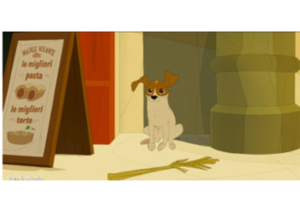
TWO BUDDIES AND A BADGER
KNUTSEN & LUDVIGSEN OG DEN FÆLE RASPUTIN
Režie: Rasmus A. Sivertsen, Rune Spaans
A zany, musical road movie about two old friends and a badger who embark on an excessively grand adventure. Starring the musical duo Knutsen & Ludvigsen, world famous in Norway
